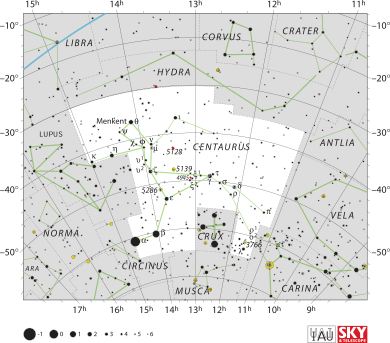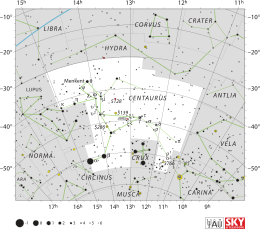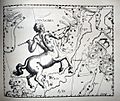Centaurus facts for kids
| Constellation | |

List of stars in Centaurus
|
|
| Abbreviation | Cen |
|---|---|
| Genitive | Centauri |
| Pronunciation | genitive |
| Symbolism | the Centaur |
| Right ascension | 13 |
| Declination | −50 |
| Quadrant | SQ3 |
| Area | 1060 sq. deg. (9th) |
| Main stars | 11 |
| Bayer/Flamsteed stars |
69 |
| Stars with planets | 14 |
| Stars brighter than 3.00m | 10 |
| Stars within 10.00 pc (32.62 ly) | 8 |
| Brightest star | α Cen (−0.27m) |
| Messier objects | 0 |
| Meteor showers | Alpha Centaurids Omicron Centaurids Theta Centaurids |
| Bordering constellations |
Antlia Carina Circinus Crux Hydra Libra (corner) Lupus Musca Vela |
| Visible at latitudes between +25° and −90°. Best visible at 21:00 (9 p.m.) during the month of May. |
|
Centaurus is a large group of stars, also known as a constellation. You can see it in the southern part of the night sky. It's named after a centaur, a mythical creature that is half human and half horse. Long ago, a famous astronomer named Ptolemy listed Centaurus as one of the first 48 constellations. Today, it's one of the 88 constellations officially recognized by astronomers worldwide.
Contents
What is Centaurus?
Centaurus is one of the biggest constellations in the sky. It covers a large area, making it the ninth largest constellation. It is part of a group of constellations called the Hercules Family. This family includes other constellations like Crux and Lupus.
Stars in Centaurus
Centaurus is home to many interesting stars. It has 11 main stars that form its shape. It also has 14 stars that are known to have planets orbiting them.
Alpha Centauri: Our Closest Star Neighbor
The brightest star in Centaurus is called Alpha Centauri. It's not just one star, but actually a system of three stars! One of these stars is named Proxima Centauri. Proxima Centauri is super important because it is the closest star to our Sun, besides the Sun itself. It's about 4.24 light-years away from us.
Other Bright Stars
Another bright star in Centaurus is Beta Centauri. It is also known as Hadar. This star is very hot and bright. It helps form the shape of the centaur in the sky.
The Shapley Supercluster
If you look in the direction of Centaurus, you'll find something amazing. It's called the Shapley Supercluster. Imagine a huge collection of galaxies, much bigger than our own Milky Way! This supercluster is the largest known group of galaxies close to us in the universe. It's like a giant cosmic city made of countless star systems.
Meteor Showers
Sometimes, you can see special meteor showers coming from the direction of Centaurus. These are called the Alpha Centaurids, Omicron Centaurids, and Theta Centaurids. A meteor shower happens when Earth passes through a trail of dust left by a comet. The dust burns up in our atmosphere, creating bright streaks of light.
Images for kids
-
The two bright stars are (left) Alpha Centauri and (right) Beta Centauri. The faint red star in the center of the red circle is Proxima Centauri.
-
Centaurus in the Firmamentum Sobiescianum of Johannes Hevelius. N.B. This image is reversed from what one sees looking at the sky — it is as though one is looking at the "celestial sphere" from the outside.
See also
 In Spanish: Centaurus para niños
In Spanish: Centaurus para niños





